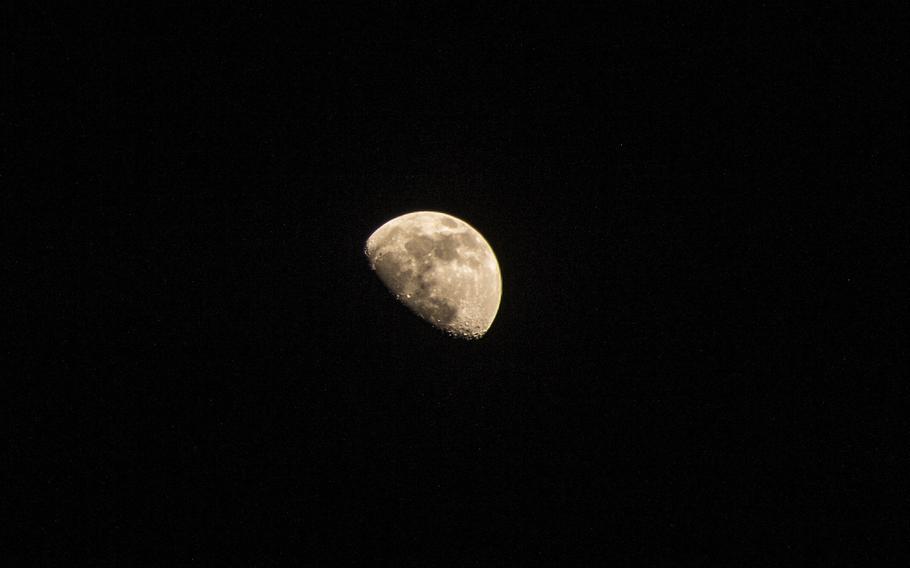
The moon seen from aboard the Wasp-class amphibious assault ship USS Iwo Jima (LHD 7) Feb. 4, 2020. (Dominick A. Cremeans/U.S. Navy)
Long ago, the moon was molten. It was covered by a magma ocean. The moon had just formed, accreting from the debris spewed into space by the violent collision of Earth with a Mars-size planet.
Ever since scientists studied moon rocks retrieved by Apollo astronauts, that has been the consensus hypothesis about the moon’s formation. Now comes a new batch of hard data to support the molten moon scenario, delivered by a rover that India deposited last year near the lunar south pole.
In a paper published Wednesday in the journal Nature, researchers in India offered their first scientific results from the mission, reporting that the rover found lunar soil matching that from previous missions to more equatorial regions of the moon. This is consistent with the Lunar Magma Ocean hypothesis - known as the LMO — which holds that the moon’s crust formed as magma cooled roughly 4.4 billion years ago.
The moon was much closer to Earth then and would have loomed large in the sky had anyone been around to see it.
“The Moon would have looked like a hot reddish ball,” lead author Santosh Vadawale, a professor at the Physical Research Laboratory in Ahmedabad, India, said in an email.
The moon is arguably the most studied object in the universe that is not of this Earth, having been subjected to a series of robotic and boots-on-the-ground examinations during the past six decades. Although there is consensus about its origin in a catastrophic impact, the fine details of its evolution remain the subject of scientific scrutiny by researchers across the planet. Finding new empirical evidence for the moon’s evolution, even if it’s not surprising, is salutary for any country with a lunar science program.
The moon lacks plate tectonics, and unlike Earth its surface has not been reworked and recycled through time. As a result, the moon is a vintage world, its cratered surface preserving its battered history. For scientists, it is a Rosetta Stone for the processes that formed the inner solar system.
“Understanding how planets form and why some evolved differently than others is particularly important as we now see rocky exoplanets around other stars and try to understand if any of them are Earth-like worlds,” Bethany Ehlmann, a planetary scientist at Caltech, said in an email.
The Indian rover, Pragyan, was carried to the moon’s surface by the Vikram lander, part of India’s Chandrayaan-3 mission, the country’s third lunar mission. At stake was more than planetary science. The moon has become a highly competitive realm for nations with space programs. When the lander touched down last August, celebrations erupted across India.
The rover immediately went exploring. The surface was pocked with many small craters, as well as boulders, creating a challenge for the scientific team, Vadawale said in an interview. The team had to ensure that the rover wouldn’t get bogged down or lose communication with the lander.
The rover spent 10 days in a traverse covering more than 300 feet, taking measurements of the lunar soil, or regolith, with an X-ray spectrometer. What the rover found was soil composed mostly of an igneous rock called anorthosite.
The Lunar Magma Ocean hypothesis suggests that the moon’s mantle — the layer above the metallic core and beneath the crust - formed as heavier minerals sank through the magma ocean. The lighter anorthosite rock floated, eventually forming the moon’s crust. The new measurements support the LMO hypothesis.
“The current study provides the first in-situ measurements from polar highland regions adding to the previous measurements in equatorial regions,” Vadawale said in an email.
The results are not scientifically earthshaking, according to planetary scientists not affiliated with the research. But the new data is the first from the polar region and represents a signature achievement for the Indian space program.
“To have the ground truth with the specificity of the measurements is really nice,” said Lindy Elkins-Tanton, a planetary scientist at Arizona State University.
“This kind of data shows what mobile explorers like rovers and hoppers can do on the Moon to enable scientists to ask and answer questions about planetary evolution from its more than 4 billion year geologic record,” Ehlmann said in an email.